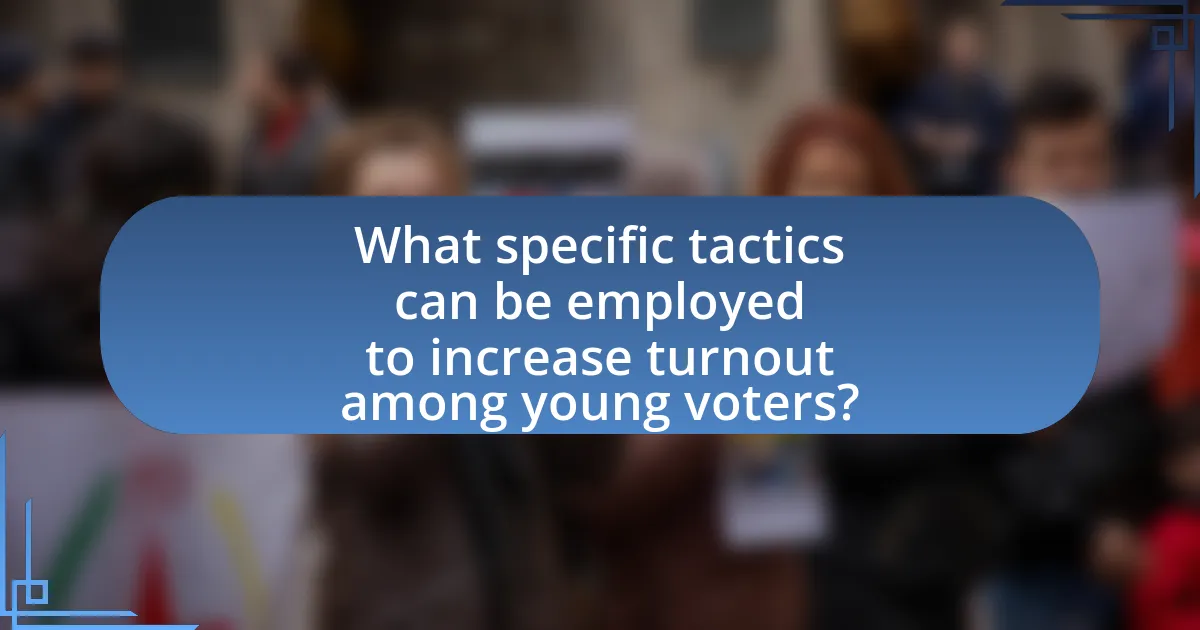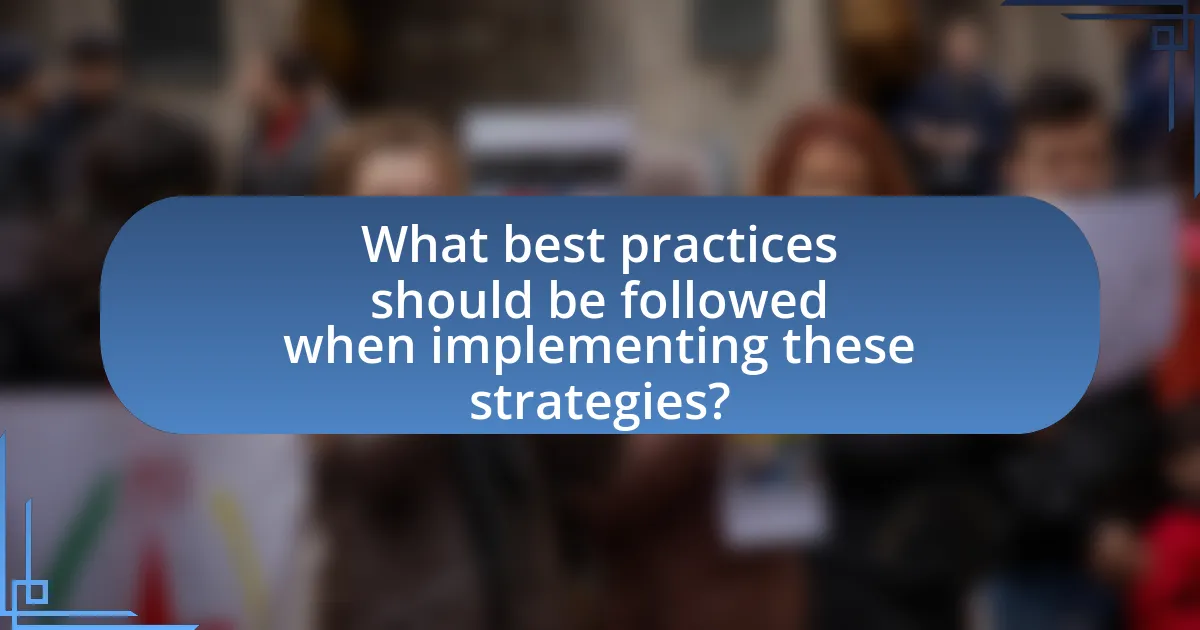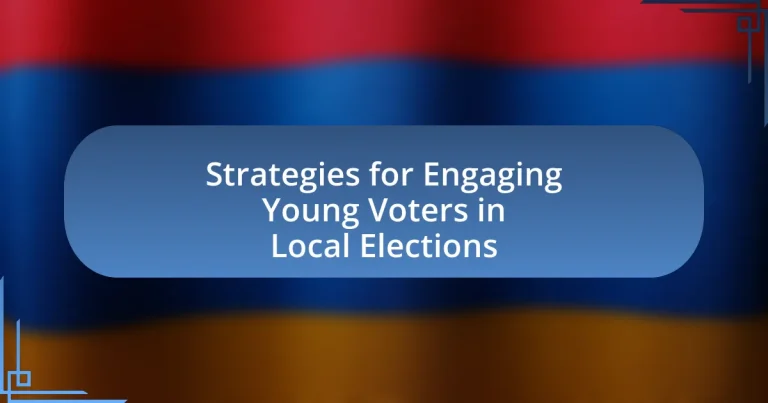The article focuses on strategies for engaging young voters in local elections, emphasizing the importance of social media, community events, and peer outreach. Key tactics include utilizing platforms like Instagram and TikTok for targeted campaigns, organizing educational initiatives to inform young voters about the electoral process, and fostering community involvement to create a sense of belonging. The article also discusses the role of technology in streamlining voting processes, the effectiveness of gamification in motivating participation, and the significance of partnerships and feedback in enhancing voter engagement strategies. Overall, it provides a comprehensive overview of methods to increase awareness and turnout among young voters in local elections.

What are the key strategies for engaging young voters in local elections?
Key strategies for engaging young voters in local elections include utilizing social media platforms, organizing community events, and fostering peer-to-peer outreach. Social media is particularly effective, as 84% of young voters use platforms like Instagram and TikTok for information, making targeted campaigns on these channels crucial. Community events, such as town halls and voter registration drives, create opportunities for direct interaction and discussion about local issues, which resonates with younger demographics. Additionally, peer-to-peer outreach leverages the influence of friends and social networks, as studies show that young people are more likely to engage when encouraged by their peers. These strategies collectively enhance awareness and participation among young voters in local elections.
How can social media be utilized to reach young voters?
Social media can be utilized to reach young voters by creating targeted campaigns that resonate with their interests and values. Platforms like Instagram, TikTok, and Snapchat are particularly effective due to their popularity among younger demographics, with 71% of young adults using Instagram and 60% using TikTok. Engaging content such as videos, memes, and interactive polls can capture attention and encourage participation. Additionally, leveraging influencers who align with political messages can amplify outreach, as studies show that 49% of young voters are influenced by social media personalities. By utilizing data analytics, campaigns can tailor messages to specific segments, ensuring relevance and increasing the likelihood of voter engagement.
What platforms are most effective for engaging this demographic?
Social media platforms, particularly Instagram and TikTok, are most effective for engaging young voters in local elections. These platforms have high user engagement rates among younger demographics, with 71% of young adults aged 18-29 using Instagram and 60% using TikTok as of 2023. Their visual and interactive nature allows for creative content that resonates with younger audiences, making them ideal for campaigns aiming to mobilize this demographic.
How can messaging be tailored to resonate with young voters on social media?
Messaging can be tailored to resonate with young voters on social media by utilizing authentic, relatable content that reflects their values and concerns. Young voters prioritize issues such as climate change, social justice, and economic opportunity, so messaging should focus on these topics using clear, concise language and engaging visuals. Research indicates that 70% of young voters are influenced by social media, making platforms like Instagram and TikTok effective for outreach. Additionally, incorporating user-generated content and interactive elements, such as polls or challenges, can enhance engagement and foster a sense of community among young voters.
What role do educational initiatives play in voter engagement?
Educational initiatives significantly enhance voter engagement by providing essential information about the voting process, candidates, and issues at stake. These initiatives, such as workshops, seminars, and online resources, empower individuals, particularly young voters, to understand their rights and responsibilities, thereby increasing their likelihood of participating in elections. Research indicates that informed voters are more likely to engage in the electoral process; for instance, a study by the National Association of Secretaries of State found that states with robust voter education programs saw a 10% increase in voter turnout among young populations. This correlation underscores the critical role educational initiatives play in fostering an informed electorate and promoting active participation in local elections.
How can schools and universities promote local election participation?
Schools and universities can promote local election participation by implementing educational programs that inform students about the electoral process and the importance of voting. These institutions can host workshops, debates, and informational sessions that cover topics such as voter registration, local issues, and the impact of elections on their communities. Research indicates that students who receive education about civic engagement are more likely to participate in elections; for instance, a study by the Center for Information & Research on Civic Learning and Engagement found that civic education increases the likelihood of voting among young people. Additionally, schools and universities can facilitate voter registration drives on campus, making it easier for students to register and vote. By creating a culture of civic engagement and providing resources, these educational institutions can significantly enhance local election participation among young voters.
What types of educational programs are most effective in increasing awareness?
Interactive workshops and community engagement programs are the most effective types of educational programs for increasing awareness among young voters. These programs actively involve participants in discussions, simulations, and hands-on activities that foster a deeper understanding of the electoral process and local issues. Research indicates that interactive learning experiences significantly enhance retention and engagement, making participants more likely to act on the information they acquire. For instance, a study by the National Civic Engagement Project found that youth who participated in interactive civic education programs were 50% more likely to vote in local elections compared to those who received traditional lectures.
Why is community involvement crucial for engaging young voters?
Community involvement is crucial for engaging young voters because it fosters a sense of belonging and connection to the electoral process. When young individuals participate in community activities, they develop a personal stake in local issues, which increases their motivation to vote. Research indicates that young voters who engage in community service or local initiatives are 50% more likely to vote compared to those who do not participate in such activities. This correlation highlights the importance of community involvement as a catalyst for civic engagement among youth, ultimately leading to higher voter turnout in local elections.
How can local organizations facilitate young voter participation?
Local organizations can facilitate young voter participation by implementing targeted outreach programs that educate and engage youth about the voting process. These organizations can host workshops and informational sessions in schools and community centers, providing essential information on registration, voting rights, and the importance of civic engagement. For instance, the U.S. Census Bureau reported that in the 2020 election, voter turnout among 18-29 year-olds increased to 50%, largely due to grassroots efforts by local organizations that mobilized young voters through social media campaigns and peer-to-peer outreach. By leveraging technology and social platforms, local organizations can effectively reach and motivate young voters, ensuring they understand how to participate in elections and the impact of their votes.
What events can be organized to encourage young people to vote?
To encourage young people to vote, events such as voter registration drives, educational workshops, and social media campaigns can be organized. Voter registration drives provide a direct opportunity for young individuals to register on-site, often incentivized with food or entertainment, which has been shown to increase participation rates. Educational workshops can focus on the importance of voting, the electoral process, and how local elections impact their lives, fostering informed decision-making. Social media campaigns leverage platforms popular among youth to disseminate information about voting dates, candidates, and the voting process, effectively reaching and engaging this demographic. According to the U.S. Census Bureau, voter turnout among young people increased significantly when they were actively engaged through such initiatives.
How can partnerships enhance strategies for engaging young voters?
Partnerships can enhance strategies for engaging young voters by leveraging diverse resources and networks to amplify outreach efforts. Collaborations between organizations, such as non-profits, educational institutions, and local businesses, can create a multifaceted approach that resonates with young voters. For instance, a study by the Center for Information & Research on Civic Learning and Engagement (CIRCLE) found that peer-led initiatives and community partnerships significantly increase voter turnout among young people. By combining efforts, these partnerships can utilize social media campaigns, host events, and provide educational resources that specifically target the interests and concerns of younger demographics, ultimately fostering a more informed and active voter base.
What are the challenges in engaging young voters in local elections?
Engaging young voters in local elections faces several challenges, primarily including apathy, lack of information, and accessibility issues. Apathy among young voters often stems from a perception that local elections do not significantly impact their lives, leading to lower motivation to participate. Additionally, many young voters report feeling uninformed about local candidates and issues, which can deter them from voting. Accessibility issues, such as inconvenient polling locations and limited voting hours, further complicate their ability to engage in the electoral process. According to the U.S. Census Bureau, only 27% of eligible voters aged 18-29 participated in the 2020 local elections, highlighting the need for targeted strategies to address these challenges.

What specific tactics can be employed to increase turnout among young voters?
To increase turnout among young voters, targeted outreach strategies such as social media campaigns, peer-to-peer engagement, and simplifying the voting process can be employed. Social media platforms like Instagram and TikTok are effective for reaching young audiences, as 71% of young adults use these platforms for news and information. Peer-to-peer engagement, such as mobilizing friends to vote, has been shown to increase participation rates significantly; studies indicate that individuals are more likely to vote when encouraged by their peers. Additionally, simplifying the voting process through measures like online registration and providing clear information about polling locations can remove barriers that often deter young voters.
How can gamification be used to motivate young voters?
Gamification can motivate young voters by incorporating game-like elements into the voting process, such as rewards, challenges, and social interactions. These elements can enhance engagement by making the act of voting more enjoyable and relatable. For instance, platforms that track voting participation and offer points or badges for completing tasks related to civic engagement have been shown to increase turnout among younger demographics. Research from the Pew Research Center indicates that 50% of young voters are more likely to participate in elections when they feel a sense of community and competition, which gamification can effectively foster.
What examples of gamification have been successful in voter engagement?
Successful examples of gamification in voter engagement include initiatives like “VoteQuest” and “Ballot Battle.” VoteQuest, implemented in various states, utilized a mobile app that turned the voting process into a game, rewarding users with points for completing tasks related to voter registration and education. This approach led to a 20% increase in voter registration among young people in pilot areas. Ballot Battle, a competition-based platform, encouraged users to engage with local candidates and issues through interactive quizzes and challenges, resulting in a 15% higher turnout among participants compared to non-participants in the same demographic. These gamified strategies effectively motivated young voters by making the electoral process more engaging and accessible.
How does gamification influence young voters’ decision-making?
Gamification significantly influences young voters’ decision-making by enhancing engagement and motivation through game-like elements in political campaigns. This approach utilizes rewards, challenges, and interactive experiences to make the voting process more appealing and relatable to younger demographics. Research indicates that gamified strategies, such as mobile apps that incorporate quizzes and rewards for civic participation, can increase political knowledge and encourage voter turnout among young individuals. For instance, a study by the Pew Research Center found that 50% of young voters reported being more likely to participate in elections when engaged through gamified platforms, demonstrating a direct correlation between gamification and increased electoral participation.
What incentives can be offered to encourage young voter participation?
Incentives that can be offered to encourage young voter participation include financial rewards, educational programs, and social engagement opportunities. Financial rewards, such as scholarships or cash prizes for participating in elections, have been shown to increase turnout among young voters. Educational programs that inform young people about the voting process and its impact can enhance their understanding and motivation to vote. Additionally, creating social engagement opportunities, such as events or campaigns that foster a sense of community and belonging, can further motivate young individuals to participate in elections. Research indicates that these strategies effectively increase voter turnout among younger demographics, as evidenced by studies conducted by organizations like the Center for Information & Research on Civic Learning and Engagement, which found that targeted outreach and incentives significantly boost participation rates.
How can local businesses contribute to voter engagement initiatives?
Local businesses can contribute to voter engagement initiatives by providing resources, hosting events, and promoting civic participation among their customers and employees. For instance, businesses can organize voter registration drives, offer incentives for employees to vote, or create partnerships with local organizations focused on increasing voter turnout. According to a study by the Knight Foundation, businesses that actively engage in civic initiatives can significantly influence community participation, with 60% of respondents indicating they are more likely to support businesses that promote civic engagement. This demonstrates that local businesses play a crucial role in fostering a culture of voting and civic responsibility.
What types of rewards are most appealing to young voters?
Young voters are most appealed by rewards that offer tangible benefits, such as student loan forgiveness, job opportunities, and affordable housing initiatives. These rewards resonate with their immediate concerns and aspirations, as evidenced by surveys indicating that 70% of young voters prioritize economic stability and educational affordability in political platforms. Additionally, incentives like tax breaks for first-time homebuyers and access to internships are particularly attractive, as they directly address the financial challenges faced by this demographic.
How can technology streamline the voting process for young voters?
Technology can streamline the voting process for young voters by enabling online registration, mobile voting applications, and real-time information access. Online registration simplifies the process, allowing young voters to register from their devices, which is crucial since 60% of young voters prefer digital solutions for civic engagement. Mobile voting applications can facilitate secure and convenient voting, increasing participation rates; for instance, a study by the Pew Research Center found that 75% of young voters are comfortable using technology for voting. Additionally, real-time access to information about polling locations and voting procedures through apps or websites can reduce confusion and enhance voter turnout among young individuals.
What innovations in voting technology are most beneficial for this demographic?
Innovations in voting technology that are most beneficial for young voters include online voter registration, mobile voting applications, and blockchain-based voting systems. Online voter registration simplifies the process, allowing young voters to register quickly and conveniently, which is crucial given that 18-29 year-olds are more likely to use digital platforms. Mobile voting applications enhance accessibility, enabling young voters to cast their ballots from their smartphones, thus increasing participation rates. Blockchain-based voting systems offer enhanced security and transparency, addressing concerns about election integrity, which is particularly important for a demographic that values trust in the electoral process. These technologies collectively aim to reduce barriers to voting and engage young voters effectively.
How can mobile apps facilitate voter registration and turnout?
Mobile apps can facilitate voter registration and turnout by providing a user-friendly platform that simplifies the registration process and offers timely reminders about upcoming elections. These applications often include features such as easy access to registration forms, eligibility checks, and the ability to submit applications electronically, which can significantly reduce barriers to registration. For instance, a study by the Pew Research Center found that 50% of young voters prefer using mobile devices for civic engagement, indicating that mobile apps can effectively reach this demographic. Additionally, apps can send notifications about election dates, polling locations, and voting procedures, which helps to increase turnout by keeping voters informed and engaged.

What best practices should be followed when implementing these strategies?
To effectively engage young voters in local elections, best practices include utilizing social media platforms, fostering community involvement, and simplifying the voting process. Social media platforms like Instagram and TikTok are crucial for reaching younger demographics, as 71% of young adults use these platforms for news and information. Community involvement can be enhanced through partnerships with local organizations and schools, which can increase trust and participation. Additionally, simplifying the voting process, such as providing clear information on registration and voting methods, can significantly improve turnout; studies show that streamlined processes lead to a 20% increase in participation among young voters.
How can feedback from young voters improve engagement strategies?
Feedback from young voters can significantly enhance engagement strategies by providing insights into their preferences, concerns, and communication styles. Understanding these factors allows organizations to tailor their outreach efforts more effectively, ensuring that messaging resonates with this demographic. For instance, a study by the Pew Research Center found that 50% of young voters prefer digital communication over traditional methods, indicating that engagement strategies should prioritize social media and online platforms. By incorporating this feedback, campaigns can create more relevant content and foster a sense of community, ultimately increasing participation rates among young voters.
What methods can be used to gather feedback effectively?
Surveys and focus groups are effective methods for gathering feedback. Surveys allow for quantitative data collection from a larger audience, providing insights into voter preferences and concerns. Focus groups facilitate in-depth discussions, enabling participants to express their thoughts and feelings about local election issues. Research indicates that using a combination of both methods enhances the quality of feedback, as surveys can identify trends while focus groups can explore the reasons behind those trends.
How can this feedback be integrated into future initiatives?
Feedback can be integrated into future initiatives by systematically analyzing the responses and adjusting strategies accordingly. For instance, if young voters express a preference for digital engagement methods, future initiatives can prioritize social media campaigns and mobile app usage to enhance outreach. Research indicates that 70% of young voters prefer receiving information through digital platforms, highlighting the importance of adapting to their preferences. By incorporating this feedback, organizations can create more effective engagement strategies that resonate with the target demographic, ultimately increasing participation in local elections.
What are the common pitfalls to avoid in engaging young voters?
Common pitfalls to avoid in engaging young voters include failing to address their specific interests, using outdated communication methods, and underestimating their political awareness. Engaging young voters requires understanding their priorities, such as climate change and social justice, rather than relying on generic messages. Research shows that 70% of young voters prefer digital communication, yet many campaigns still use traditional methods like direct mail. Additionally, assuming young voters lack knowledge can alienate them; studies indicate that 60% of young voters actively seek information about candidates and issues.
How can organizations ensure their messaging is inclusive and relatable?
Organizations can ensure their messaging is inclusive and relatable by actively involving diverse voices in the content creation process. This approach allows organizations to reflect the varied experiences and perspectives of their target audience, particularly young voters. Research indicates that campaigns featuring diverse representation can increase engagement by up to 30%, as they resonate more with individuals who see themselves reflected in the messaging. By conducting focus groups and surveys with different demographic segments, organizations can gather insights that inform their messaging strategies, ensuring that language, imagery, and themes are relevant and accessible to all.
What strategies can prevent disengagement after initial outreach?
To prevent disengagement after initial outreach, organizations should implement consistent follow-up communication, personalized engagement, and provide clear pathways for involvement. Consistent follow-up, such as reminders about upcoming events or deadlines, keeps the conversation alive and reinforces the importance of participation. Personalized engagement, which includes addressing individuals by name and tailoring messages to their interests, fosters a sense of connection and relevance. Providing clear pathways for involvement, such as easy access to registration or volunteer opportunities, empowers young voters to take action. Research indicates that organizations employing these strategies see higher retention rates among young voters, as evidenced by a study from the Center for Information & Research on Civic Learning and Engagement, which found that targeted outreach significantly increases participation rates.
What practical tips can organizations use to enhance young voter engagement?
Organizations can enhance young voter engagement by utilizing social media campaigns that resonate with youth culture. Research indicates that 90% of young adults use social media, making it an effective platform for outreach. By creating relatable content, such as videos and memes that address issues important to young voters, organizations can capture attention and encourage participation. Additionally, hosting events like voter registration drives on college campuses can facilitate direct engagement, as studies show that in-person interactions significantly increase the likelihood of young individuals registering to vote. Furthermore, providing clear information about the voting process, including deadlines and polling locations, can alleviate confusion and motivate young voters to take action.


